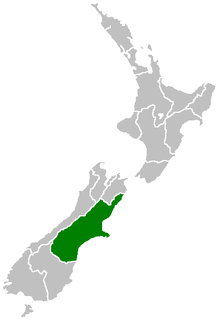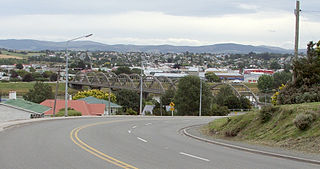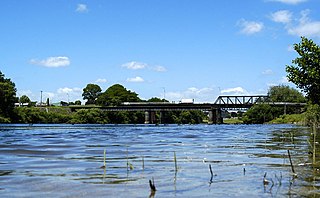| Look up Waikato or waikato in Wiktionary, the free dictionary. |
Waikato is a top-tier local government region of New Zealand extending from Thames-Coromandel District to Taupo District.

Waikato is a local government region of the upper North Island of New Zealand. It covers the Waikato District, Hauraki, Coromandel Peninsula, the northern King Country, much of the Taupo District, and parts of Rotorua District. It is governed by the Waikato Regional Council.
Waikato may also refer to:
- Waikato District, a second-tier local government region of New Zealand (part of Waikato Region)
- Waikato, area subjected to the 1860s Invasion of the Waikato
- Waikato River, longest river in New Zealand
- Waikato (iwi), a Māori tribe
- Waikato (New Zealand electorate), a general electorate
- Hauraki-Waikato, a Māori electorate
- Port Waikato, a small town
- HMNZS Waikato (F55), a frigate

Waikato District is a territorial authority of New Zealand, in the northern part of Waikato Region, North Island. Waikato District is administered by the Waikato District Council, with headquarters in Ngaruawahia.

The Invasion of the Waikato was the biggest and most important campaign of the 19th century New Zealand Wars, fought in the North Island of New Zealand between the military forces of the colonial government and a federation of Māori tribes known as the "Kingitanga Movement". The Waikato is a territorial region with a northern boundary somewhat south of the city of Auckland. Hostilities lasted for nine months, from July 1863 to April 1864. The invasion was aimed at crushing Kingite power, which was seen as a threat to British authority, and also at driving Waikato Māori from their territory in readiness for occupation and settlement by Europeans. The campaign was fought by a peak of about 14,000 Imperial and colonial troops and about 4,000 Māori warriors drawn from more than half the major North Island tribal groups.

The Waikato River is the longest river in New Zealand, running for 425 kilometres (264 mi) through the North Island. It rises in the eastern slopes of Mount Ruapehu, joining the Tongariro River system and flowing through Lake Taupo, New Zealand's largest lake. It then drains Taupo at the lake's northeastern edge, creates the Huka Falls, and flows northwest through the Waikato Plains. It empties into the Tasman Sea south of Auckland, at Port Waikato. It gives its name to the Waikato Region that surrounds the Waikato Plains. The present course of the river was largely formed about 17,000 years ago. Contributing factors were climate warming, forest being reestablished in the river headwaters and the deepening, rather than widening, of the existing river channel. The channel was gradually eroded as far up river as Piarere, leaving the old Hinuera channel through the Hinuera Gap high and dry. The remains of the old river path can be clearly seen at Hinuera where the cliffs mark the ancient river edges. The river's main tributary is the Waipa River, which has its confluence with the Waikato at Ngaruawahia.
- Organisations
- Waikato Rugby Union, a governing body for rugby union
- Waikato Rugby League, a governing body for rugby league
- Waikato FC, a football (soccer) club
- Waikato Australian Football League
- Diocese of Waikato
- University of Waikato

The Waikato Rugby Union (WRU) is the official governing body of rugby union in the Waikato area in the North Island of New Zealand. Its senior representative team competes in the Mitre 10 Cup, and won the inaugural Air New Zealand Cup in 2006.

Waikato Rugby League is the local sporting body responsible for the administration of rugby league in the Waikato region of New Zealand. The WRL are represented by the Waikato rugby league team. They are currently part of the Upper Central Zone along with Coastline Rugby League and Bay of Plenty Rugby League.
Waikato AFL is an Australian rules football competition in Waikato, New Zealand and is one of the Leagues governed by AFL New Zealand.
| This disambiguation page lists articles associated with the title Waikato. If an internal link led you here, you may wish to change the link to point directly to the intended article. |









